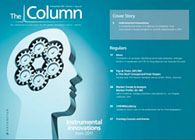Something fishy
A new study has found that treated wastewater contains a wide range of antiandrogens (AA) ? compounds that can block male hormones and that can accumulate in fish.
A new study has found that treated wastewater contains a wide range of antiandrogens (AA) – compounds that can block male hormones and that can accumulate in fish.1
Profiling of AA contaminants in wastewater and fish was conducted using HPLC in combination with in vitro androgen receptor transcription screens. This took place over 10 days as rainbow trout were exposed to effluent from a domestic sewage plant in the UK. The bile in the fish was extracted and separated into fractions, using reversed-phase high performance liquid chromatography. The bile was profiled for AA activity using yeast (anti-YAS) and mammalian-based androgen receptor transcription screens. The predominant fractions with AA activity in both androgen receptor screens contained the germicides chlorophene and triclosan, and together these contaminants accounted for over half of the total anti-YAS activity in the fish bile. Other AA compounds identified in bile were chloroxylenol, dichlorophene, resin acids, napthols, oxybenzone, 4-nonylphenol and bisphenol A.
The study was able to identify for the first time that a diverse range of AA chemicals in wastewater is available to fish. This now need to be further examined to establish whether these compounds are a risk to the reproductive health of the fish.
1. Pawel Rostkowski et al., Environ. Sci. Technol., 2011, DOI: 10.1021/ es202966c
This story originally appeared in The Column. Click here to view that issue.
Regulatory Deadlines and Supply Chain Challenges Take Center Stage in Nitrosamine Discussion
April 10th 2025During an LCGC International peer exchange, Aloka Srinivasan, Mayank Bhanti, and Amber Burch discussed the regulatory deadlines and supply chain challenges that come with nitrosamine analysis.











